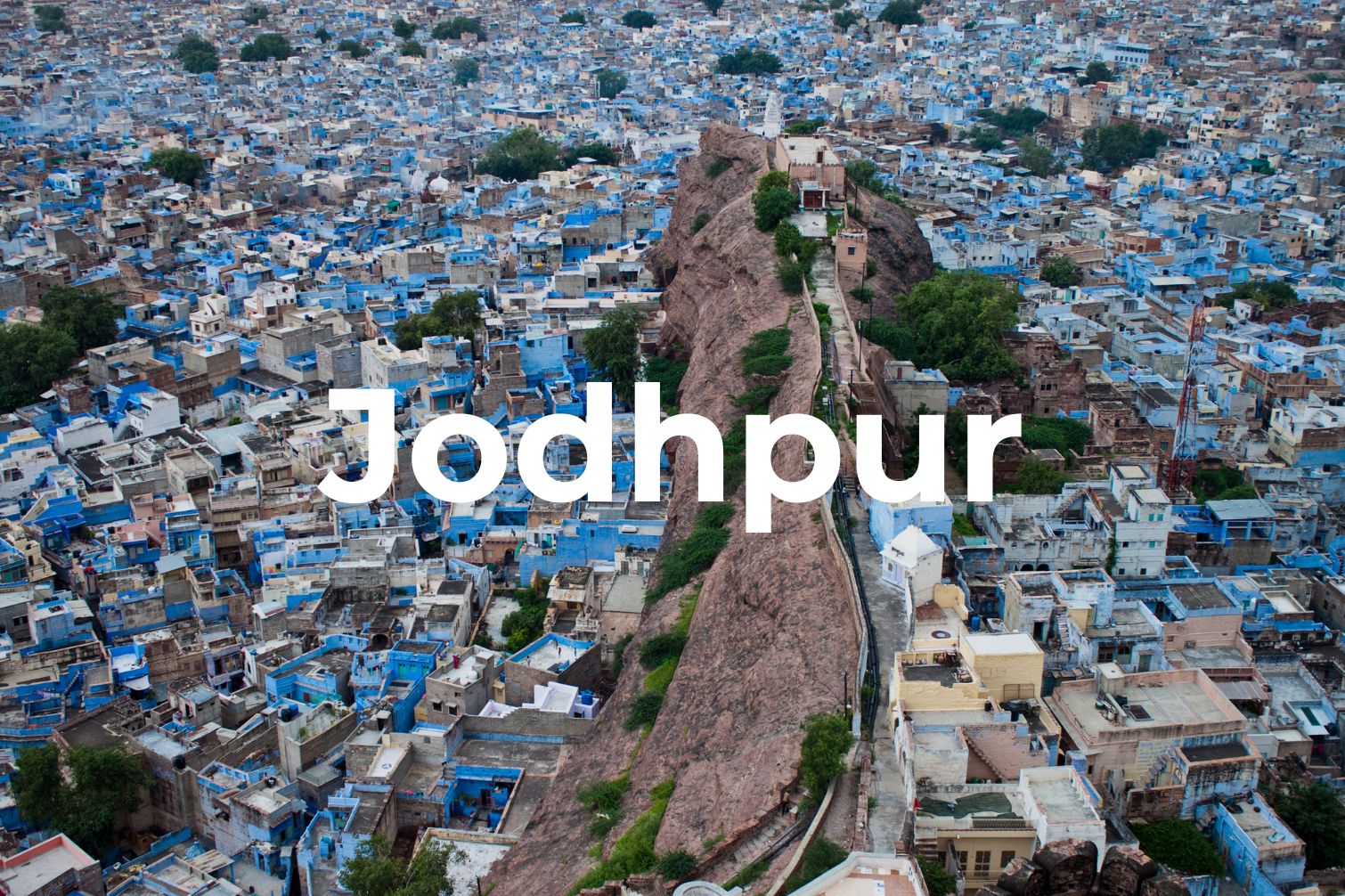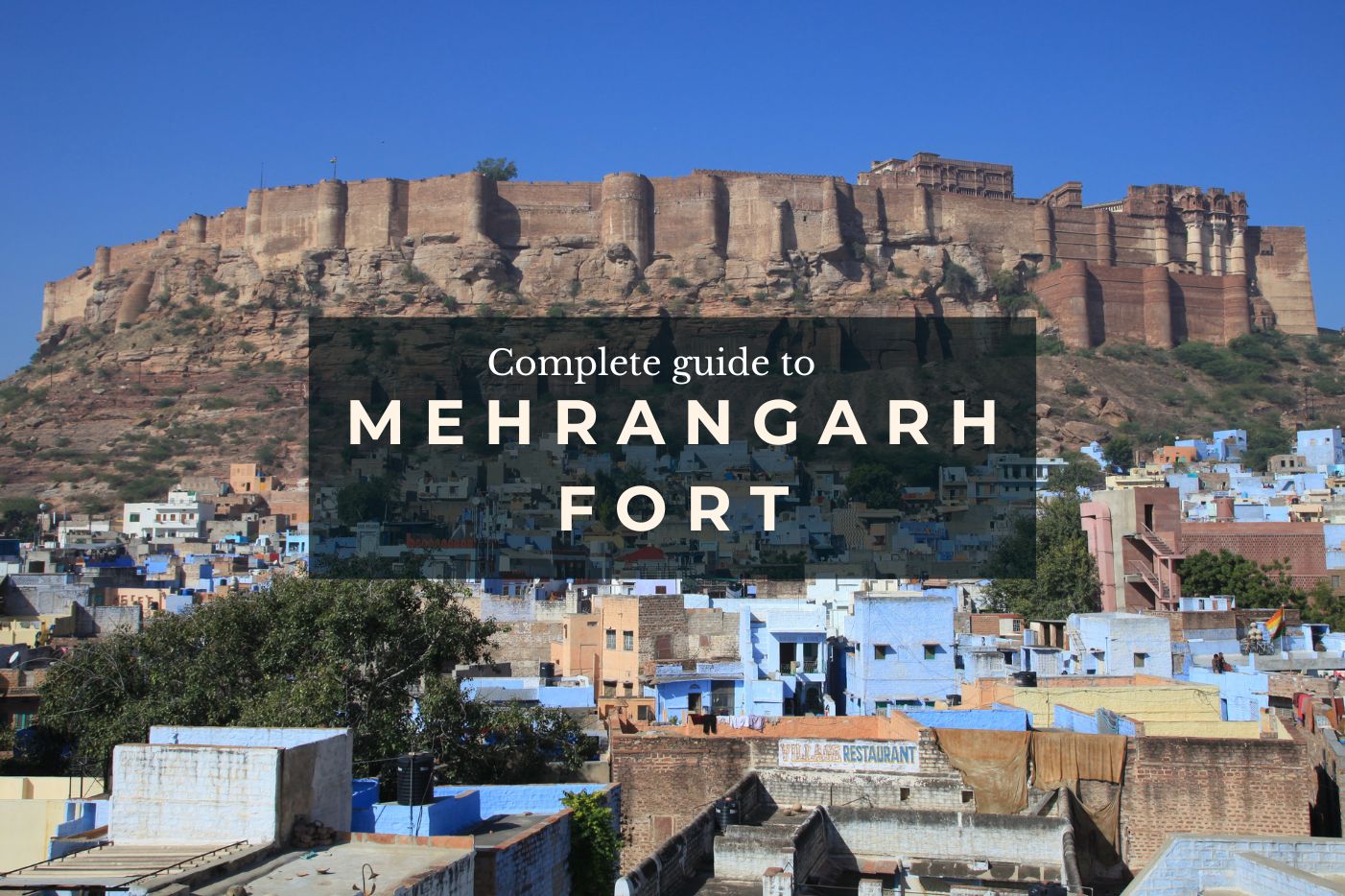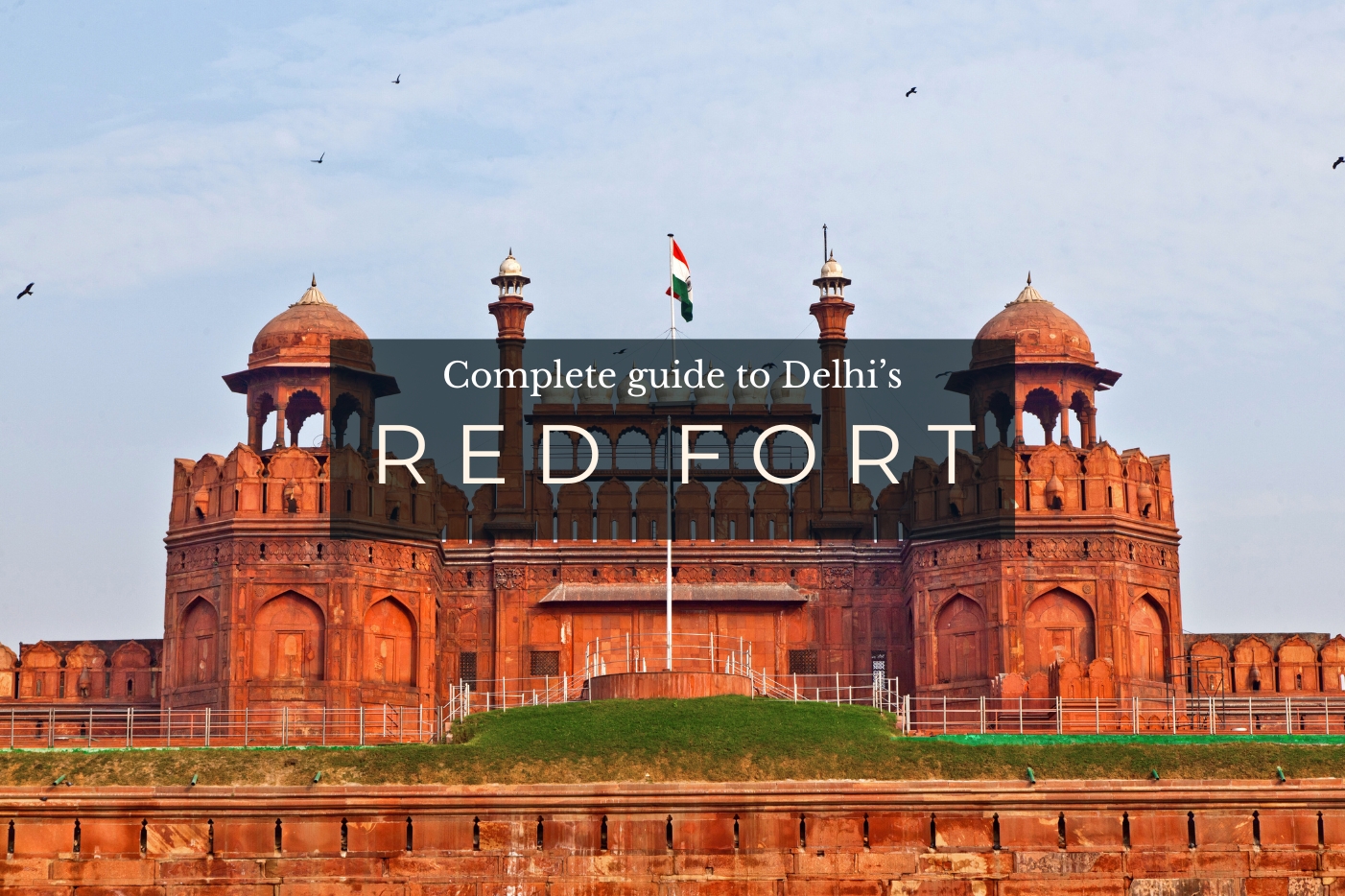If you had to pick the absolute best historical site in Sri Lanka, and there are many to choose from, it might be the ancient city of Polonnarwua.
This sprawling historical site is the ruins of a once legendary city that served as the capital of Sri Lanka during a golden age, over 1000 years ago. With its size and scale, this UNESCO World Heritage Site is often compared to Cambodia’s Angkor Wat and has some of the most well preserved ancient ruins in Sri Lanka.
Palaces, royal baths, gigantic rock carvings and massive stupas, this ancient city has a lot to offer and, if you’re a history buff, it’s an essential visit on your trip to Sri Lanka.
However, Polonnaruwa is big, and there is some pre-planning required before you visit. If you turn up unprepared, you’re going to find yourself saying things like ‘where’s the ticket booth?’ or ‘this place is huge, it’ll take forever to walk’. Don’t worry though, because in this guide to Polonnaruwa I’ve provided you with everything you need to know about visiting the ancient city.
Table of Contents
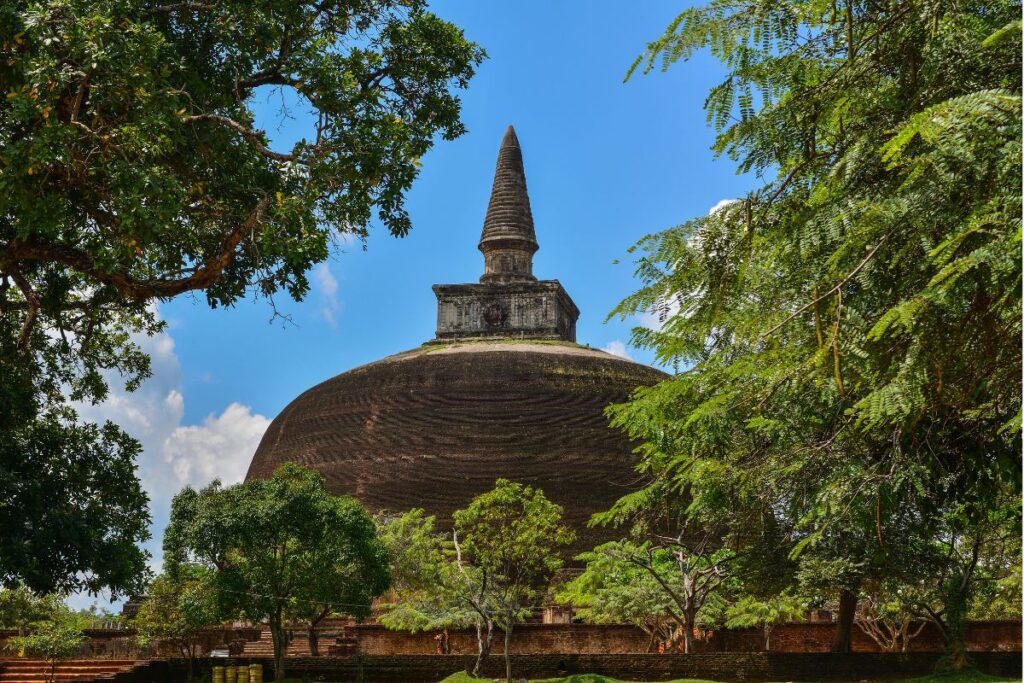
A Very Brief History of Polonnaruwa
To really appreciate this impressive historical site and understand what you’re seeing as you explore it, it helps to have a little context. So here’s a quick rundown of how it came to be.
The story of Polonnaruwa starts with another ancient city, Sri Lanka’s oldest: Anuradhapura. For over 1500 years the grand city of Anuradhapura served as the capital of various major Sri Lankan kingdoms. This was until the year 993 CE, when the Chola Kingdom from Southern India invaded, burning Anuradhapura to the ground and conquering most of the island.
With Anuradhapura in ruins, the Chola’s needed a new site for their capital in Sri Lanka, and chose the former military outpost of Polonnaruwa. Over the next few decades they developed the settlement into one worthy of a capital.
That was until a local prince, Vijayabahu the Great, unified the subjugated Sri Lankan people and revolted against the Cholas. In 1070, after 17 years of fighting, the prince took the capital of Polonnaruwa and drove the Chola’s completely from the island, starting a golden age for Sri Lanka.
Vijayabahu the Great and his successors put great effort into developing the city’s agriculture and rice cultivation. Vijayabahu’s successor declared that no drop of water from the sky should be wasted, and the irrigation system that they developed would make Polonnaruwa one of the most technologically advanced cities in the world, at least in terms of agriculture.
At its peak, Polonnaruwa was renowned for its wealth and glamour, and was known as ‘the Granary of the East’, due to the massive amounts of food it could produce, with some even referring to it as Sri Lanka’s ‘Garden of Babylon’. They constructed many grand buildings, which you can still see today, and even built the massive lake next to Polonnaruwa (Parakrama Samudra). The irrigation system built during this time still supports the surrounding rice fields to this day.
This golden age would come to an end in 1214 when Polonarruwa was invaded and burned to the ground by another kingdom from the North (the Kalingas). After Polonnaruwa, the centre of power on the island bounced around a lot, with many kingdoms vying for control, leaving Sri Lanka vulnerable to European powers in the 1500s. Sri Lanka wouldn’t be unified and self-governed again until its independence from Britain in the 20th century.
Polonnaruwa was declared a UNESCO World Heritage Site in 1982 and remains one of the most well preserved historical sites in the country.
So, now that you know how it came to be, let’s dive into this comprehensive guide to visiting Polonnaruwa.
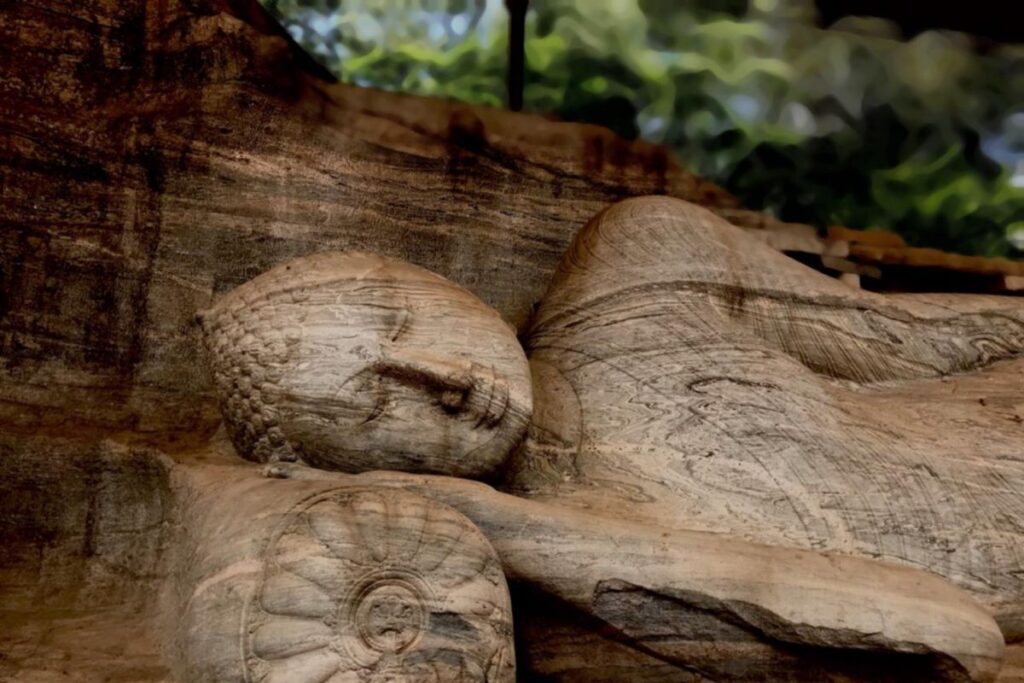
Best time to visit Polonnaruwa
The best time of year to visit Polonnaruwa is between December and March. Sri Lanka has a tropical climate with separate monsoon seasons in different parts of the island, but between these months you’ll find the heat to be the most bearable and will have the least chance of rain.
The best time of day to visit is as early as possible. In my experience, the crowds weren’t overbearing at any time of the day, but if you’re willing to get up early and arrive by 7am, you’ll be able to explore half the complex before that tropical heat sets in.
Opening Hours | At the time of writing, Polonnaruwa is open 7am to 6:30pm, 7 days.
Where to Stay
Personally, I stayed at the One More Night Hostel in Sigiriya and rented a scooter to visit Polonnaruwa on a daytrip. This hostel is great if you’re on a budget and looking to meet other travellers.
If you’re looking for budget accommodation and want to meet other travellers, then you have to stay at Roy’s Villa Hostel. Roy’s hostel is somewhat famous among Sri Lanka’s backpackers circuit, known for its sociable atmosphere. It’s so popular that it’s usually fully booked out days or sometimes weeks in advance during high season, so be sure to secure your spot here.
If you’re looking for something a little fancier and more private than a hostel, then I’d highly recommend Sigiriya Rockside Homestay.
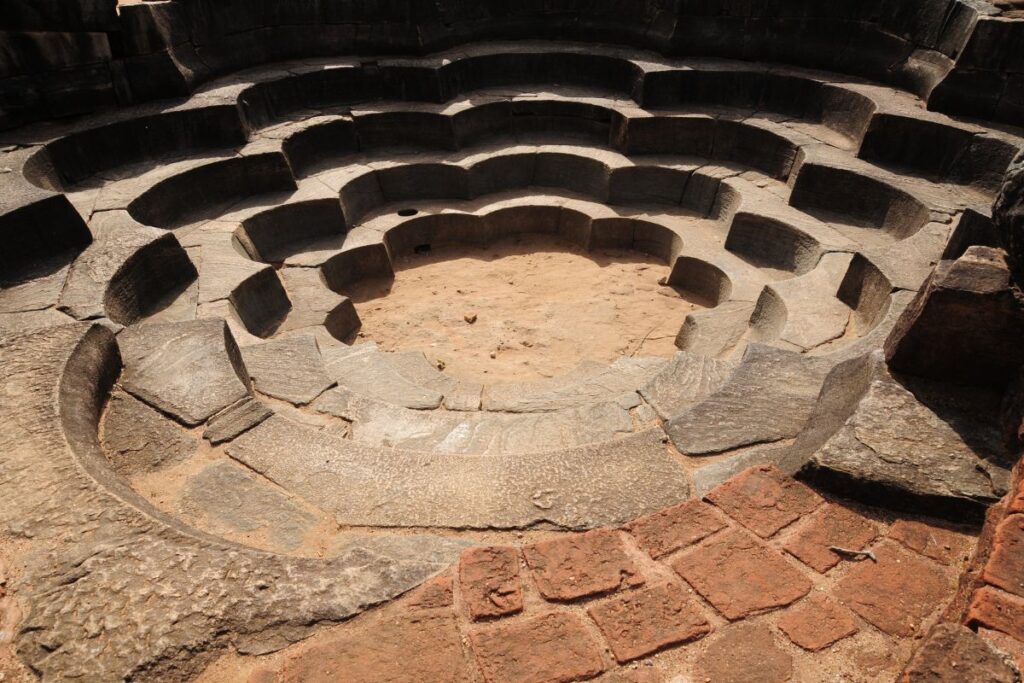
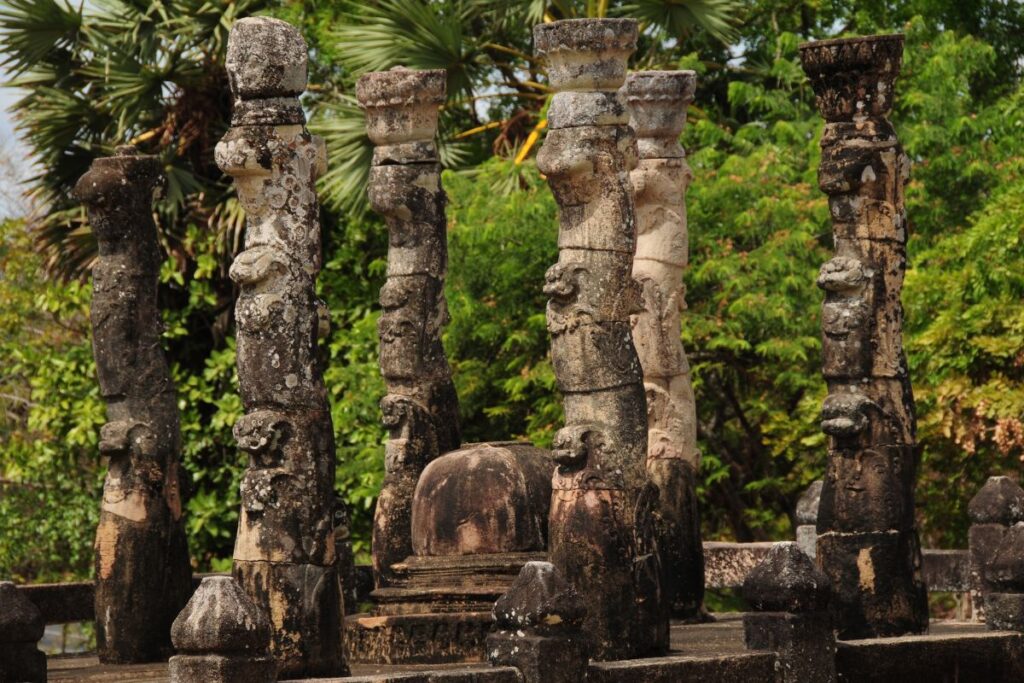
How to get to Polonnaruwa
The Polonnaruwa historical site is located in a town that is also called Polonarruwa. The modern-day town is sometimes referred to as Newtown, with the ancient city ruins essentially being the ‘old town’.
It is located in the North Central Province of Sri lanka, about 50km from Sigiriya, another popular site of the Cultural Triangle, and about 220km from Colombo, the national capital.
How you get there will of course depend on where you’re staying. It is possible to stay in the town of Polonnaruwa itself, however because there’s not much to see in town other than the ruins most people, myself included, choose to stay at Sigiriya and make a day trip to Polonnaruwa.
I wouldn’t recommend trying to visit the ruins whilst staying anywhere further away than Sigiriya, given that you’d spend the majority of your day travelling to and from, leaving too little time to see the massive complex.
From Polonnaruwa
If you’re staying in the town of Polonnaruwa, then getting to the ancient city is easy. There may be public buses you could get, but for less than $2 USD you could get a tuk tuk or rideshare (uber/lyft).
Bus from Sigiriya
There are no buses running directly from Sigiriya to Polonnaruwa, but there are from the nearby town of Inamaluwa, about 10km away. If you want to get the bus, I’d recommend hiring a tuk tuk to drive you to Inamaluwa junction, then asking the bus drivers if they’re headed to Polonnaruwa. The journey will take around 2 hours.
Cost | A tuk tuk from Sigiriya to Inamaluwa should cost around 500 LKR ($1.60 USD). A one way bus ticket from Inamaluwa to Polonnaruwa should be around 100 LKR ($0.30 USD). Total = 600 LKR ($1.90 USD).
Tuk tuk from Sigiriya
Speak with any local tuk tuk driver and you shouldn’t have any trouble arranging transport from Sigiriya to Polonnaruwa. For an additional fee, they may also drive you around the complex itself, or wait around for you to finish and drive you back to Sigiriya.
Cost | The exact cost depends on the above-mentioned things, as well as your haggling skills, but a one way tuk tuk trip from Sigiriya to Polonnaruwa will likely set you back around 1500 and 2000 LKR ($4.80 and $6.40 USD).
Scooter from Sigiriya
In my opinion the best way to get from Sigiriya to Polonnaruwa is to rent a scooter and make your own way there. Renting a scooter for a day not only allows you the freedom to stop wherever and whenever you like, but also covers your transport in the complex itself, and your transport back to Sigiriya when you’re done.
In a tourist hotspot like Sigiriya, finding a scooter to rent is not hard. If your hotel doesn’t have any available, go for a walk and look out for signs, or just ask some of the locals where you can rent a scooter.
The ride from Sigiriya should take you around 2 hours at a leisurely pace. You can stop and see the sights as you please, and may even see some wild elephants on the road.
Cost | The cost of a full day rental should cost you no more than 2000 LKR ($6.40 USD). The cost of a full tank of petrol, which should cover you for the whole day, is roughly 1200 LKR ($3.80), depending on the type of scooter.
Total = 3200 LKR ($10.20 USD).
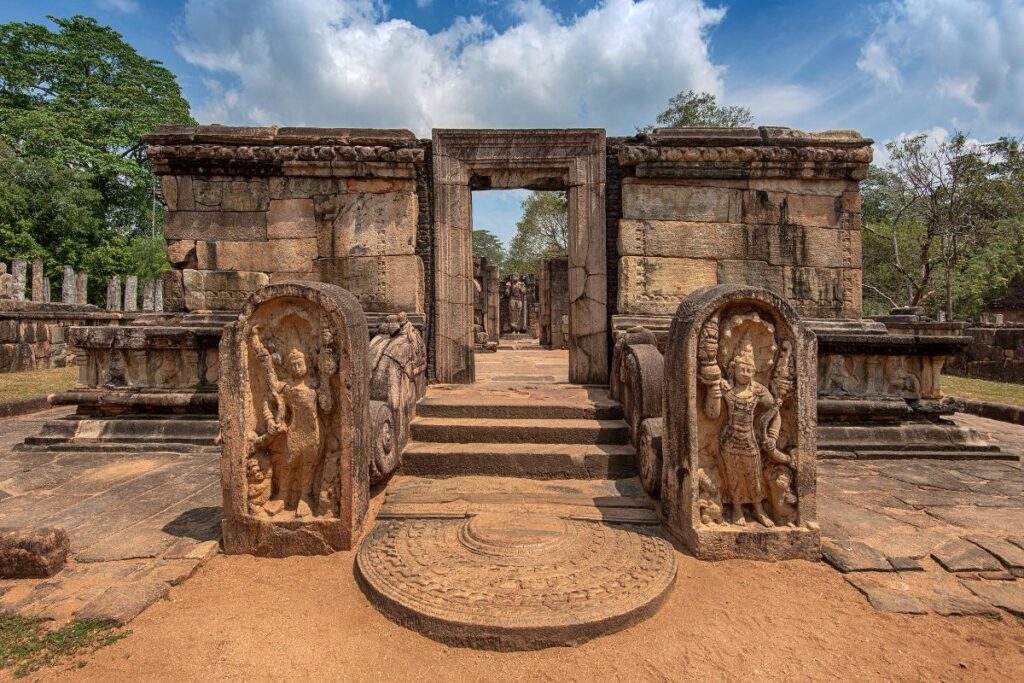
Where to Buy a Ticket to Polonnaruwa
If you attempt to go straight to the entrance to Polonnaruwa just off the highway, you’ll be turned away, because to buy your entry ticket you’ll first need to visit the Archeological Museum.
If you’re arriving by bus or hired driver, you’ll likely be dropped off at the museum anyway, but if you’re making your own way there then it can be confusing to find.
To reach the museum, you’ll need to turn off the highway and onto Bund Rd. Take the first right and you’ll find the museum, and main entrance, right in front of you.
Cost | 4500 LKR ($25 USD). This sound expensive when compared to
Getting around Polonnaruwa
The Polonnaruwa complex is quite large. After all, it was once an entire city. From the entrance of the complex to the far end is almost 4km, and the various ruins are scattered throughout, with some distance in between.
To get around this sprawling ancient city, you have a few different options.
Walk
If you’ve got the time and the energy, there’s nothing stopping you from walking around Polonnaruwa. However, this isn’t advisable. You’ll be on your feet all day, and the intense tropical heat doesn’t make it any easier.
But hey, if those things don’t bother you, go for it. There’s plenty of places to rest in the shade when you need it, and no shortage of stalls selling cold bottled water. Just make sure you allow yourself about 8 hours if you’d like to see everything Polonnaruwa has to offer.
Rent a Bike
One of the most popular ways to get around Polonnaruwa is by renting a pushbike. It’s much faster than walking and cheaper than renting a scooter. With paved roads throughout, cycling around the ruins of this ancient city at your own leisurely place makes for a great time, and should take you roughly 4 to 5 hours to see everything.
You can rent a bike at the entrance to the complex. If you’re arriving on foot, someone will likely offer you one. If not, just ask one of the employees where the bike rental is.
Cost | At the time of writing, the cost of renting a pushbike for the full day is 500 LKR ($1.60USD).
Rent a Scooter
If you feel comfortable riding a scooter (or moped or motorbike), then this is certainly the most convenient way to get around Polonnaruwa. With your own scooter, you can zoom around the complex quickly, with minimal effort, and at your own pace.
There are many places to rent a scooter; they’re everywhere in Sri Lanka. Your best bet is to ask at your hotel, they may rent their own or know someone who does. Otherwise, walk around any tourist hotspot and you’ll likely find scooters for rent.
Cost | The cost of renting for a full day depends on the type of scooter and the owner, but you should expect between 1000 to 2000 LKR ($3.20 to $6.40 USD).
Hire a Tuk Tuk
Your other option of getting around Polonnaruwa is hiring a tuk tuk and driver. For a reasonable price, your driver will take you around the whole complex, stopping at each site for as long as you like.
The plus side of this option is escaping the tropical heat and sitting in the shade as you’re chauffeured around the complex. The downside of hiring a tuk tuk is that, even though your driver will take you wherever you ask, it lacks the freedom that comes with riding your own bike or scooter.
If you choose this option, you may look to hire a tuk tuk from wherever you’re staying, which also covers your transport to and from Polonnaruwa. I’d suggest you start by asking at your hotel, but really if you talk to any local tuk tuk driver they’ll probably be more than happy to take the job.
Even if you reach the site by other means, you’ll likely find tuk tuk drivers waiting at the entrance to Polonnaruwa, available for hire.
Cost | The cost of hiring a tuk tuk depends on a few things, such as whether it’s for a full day or half day, whether they are also driving you to and from your hotel, and of course how good your haggling skills are. But if you were to hire one to drive you around the complex only, you can expect somewhere between 1500 and 2000 LKR ($4.80 and $6.40 USD).
Places to see in Polonnaruwa
Museum
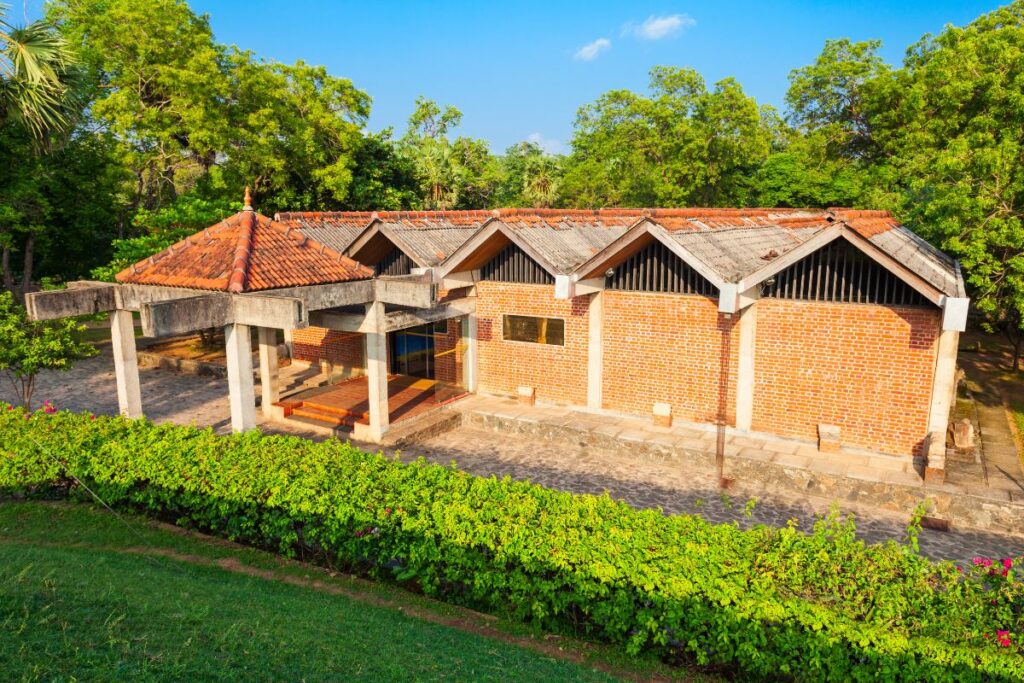
The Archeological Museum is where you’ll buy your ticket to Polonnaruwa, making it your first stop.
You will get so much more from your exploration around this ancient city if you take the time to visit this museum and learn what Polonnaruwa actually is and how it came to be. It will allow you to get so much more value from that expensive entry ticket and allow you to fully appreciate what you’re seeing around the complex.
This small museum has an impressive collection of ancient artefacts from the area, but perhaps the most valuable displays are those providing information, and the miniatures depicting what the city looked like during its heyday.
Now, when you see many of the ruins of Polonnaruwa, you’ll be able to picture what the structure really looked like.
Palace Complex Of King Nissanka
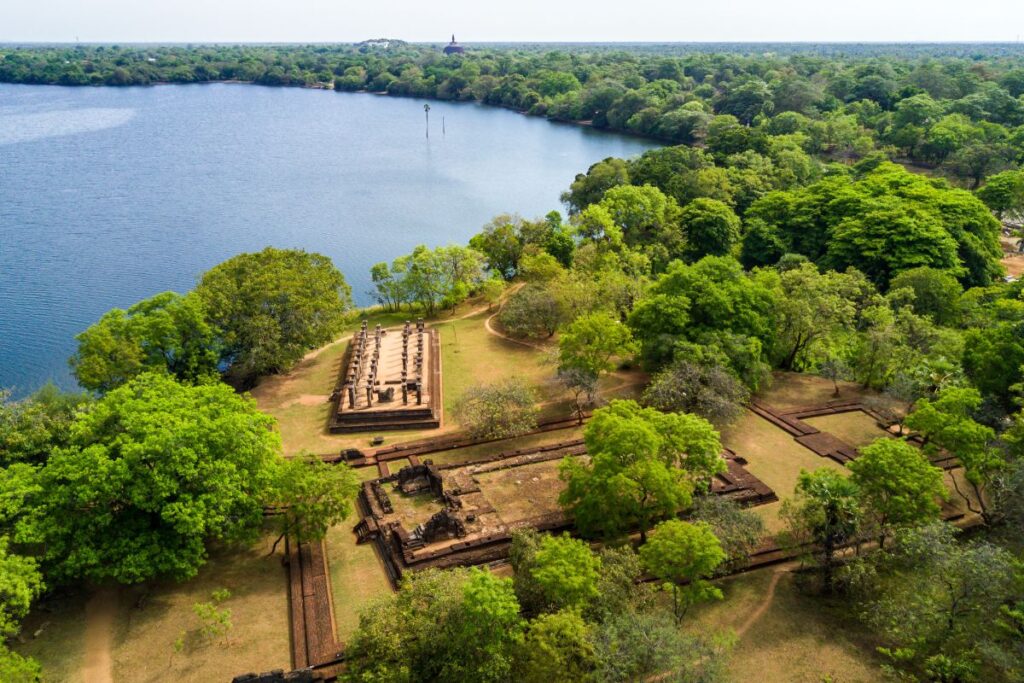
After buying your ticket and visiting the museum, you’ll find the main entrance to Polonnaruwa to your right.
The first thing you’ll come across here is the Palace of King Nissanka. Nissanka was the third ruler of Polonnaruwa after the Sri Lankans retook it from the Cholas, and he ruled from 1197 to 1196 CE after killing the previous king.
This palace complex consists of a number of impressive ruins, including the central audience hall, the royal baths and various other smaller structures like a mausoleum, and a royal ‘summer house’ on the water’s edge.
The Citadel


After seeing the Palace of King Nissanka, you’ll make your way across the highway and into the main area of Polonnaruwa. After passing the main gate, take a right and you’ll come across the next highlight that this ancient city has to offer.
Here, at the Citadel, you’ll find the remains of 2 of the most important structures at Polonnaruwa.
On your left, which unfortunately is little more than just the foundations, are the remains of the Palace of King Vijayabahu the Great. This guy was one of Sri Lanka’s greatest rulers, the first Sri Lankan ruler of Polonnaruwa, the man who took the city from the Cholas.
To the right, on the other hand, is the real highlight: the remains of the Palace of King Parakramabahu. The successor to Vijayabahu the Great, this guy is right up there as one of Polonnaruwa’s most important kings, and the city thrived under his rule. His palace clearly matched his reputation, with the massive stone pillars giving a sense of the scale of this structure. At 7 stories, it was said to be the tallest building in the city and supposedly housed a thousand bed chambers.
The other structure you’ll see at the Citadel is the audience hall. What remains today are the elevated stone foundations and the pillars, but 1000 years ago this building also had a wooden roof and was used by the king to receive guests.
The Sacred Quadrangle
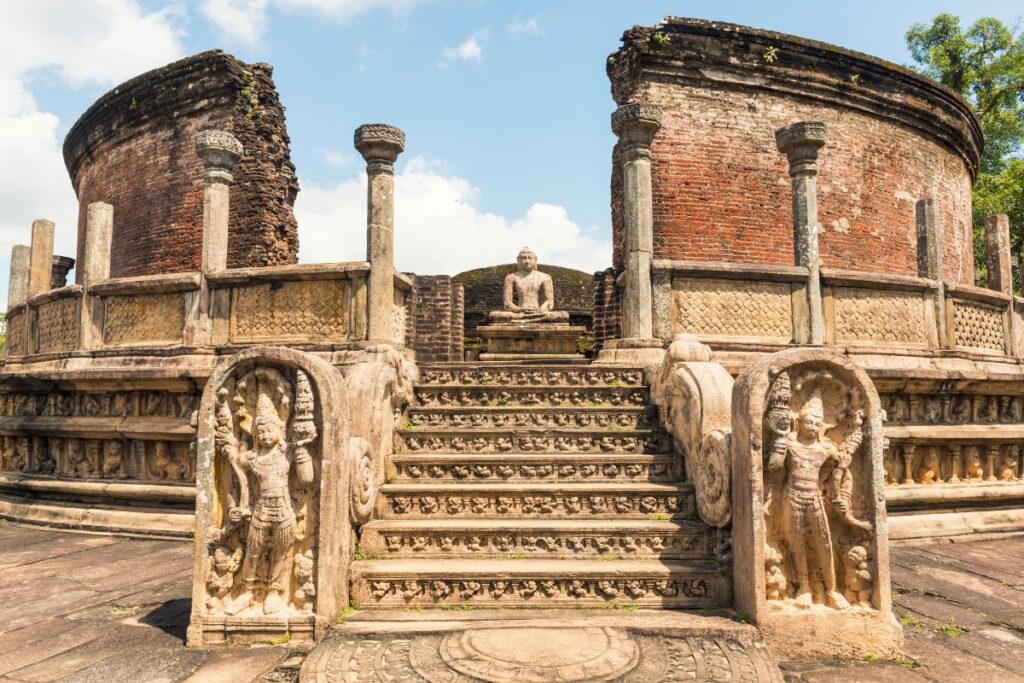

After the Citadel, you’ll follow the road north, pass the gate you entered in, and find the next highlight on your left.
The Sacred Quadrangle has some of the most impressive and well preserved ruins in all of Polonnaruwa. If you’ve ever seen a picture of Polonnaruwa, it was probably of one of the buildings here. This site was once the religious centre of the city and housed 10 impressive buildings used for worship.
The first structure you’ll see to your left is the Vatadage, a massive circular structure which was said to hold the Relic of the Tooth of the Buddha, an important religious artefact which is now held in Kandy.
Opposite this is the Hatadage, another impressive temple. It once stood 2 stories tall, and though little remains it still houses some intricately-carved statues of the Buddha.
Another highlight of the Sacred Quadrangle is the Thuparamaya, found behind the Vatadage. This structure is unique in that, while most buildings in Polonnaruwa had wooden roofs, this one is entirely made of stone, meaning it still remains in similar condition to what it was 1000 years ago, albeit with a bit of wear-and-tear.
Tip | Keep in mind, when visiting the Sacred Quadrangle, you’ll be expected to remove your shoes before entering each of the ruined structures. Even though these are 1000 years old, their religious significance in Buddhism is still recognised today.
Rankoth Vihara

As you make your way north through the ancient city, you’ll no doubt see a massive stone structure sticking out above the trees.
This massive structure is the Rankoth Vihara, one of the largest stupas in Sri Lanka (and Sri Lanka has a lot of big stupas). It was built during the reign of King Nissanka (1187 to 1196, and, thanks to its shape, this stone structure is among the best preserved in Polonnaruwa.
The Rankoth Vihara is one site you don’t want to miss on your visit.
Lankatilaka Vihara Complex

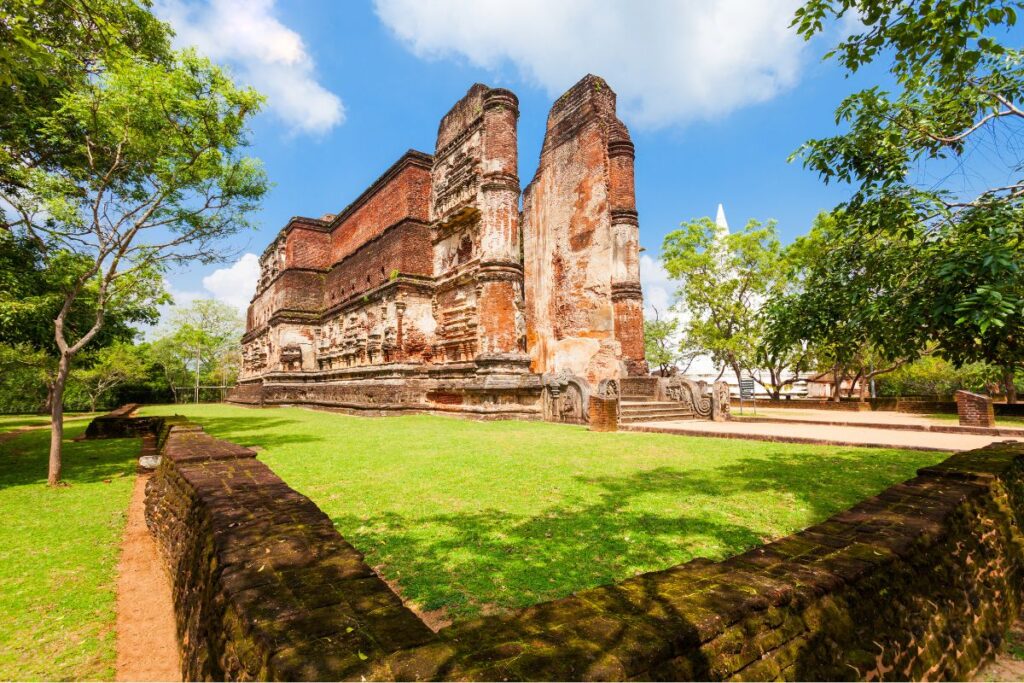
Just north of the Rankoth Vihara you’ll come across another massive temple complex.
The first thing you’ll see here is the Kiri Vihara, another stupa. It’s slightly smaller than the Rankoth Vihara, but every bit as magnificent.
Next to this is the Lankatilaka Temple itself. This is without a doubt one of the most impressive sites in all of Polonnaruwa, and the height of the ruined walls give you a sense of how massive it was 900 years ago. Built during the reign of King Parakramabahu (1153 to 1186), this temple once housed a statue of Buddha standing 13m tall, some of which still remains today.
Lankatilaka is without a doubt one the best sites in this ancient city.
Gal Vihara
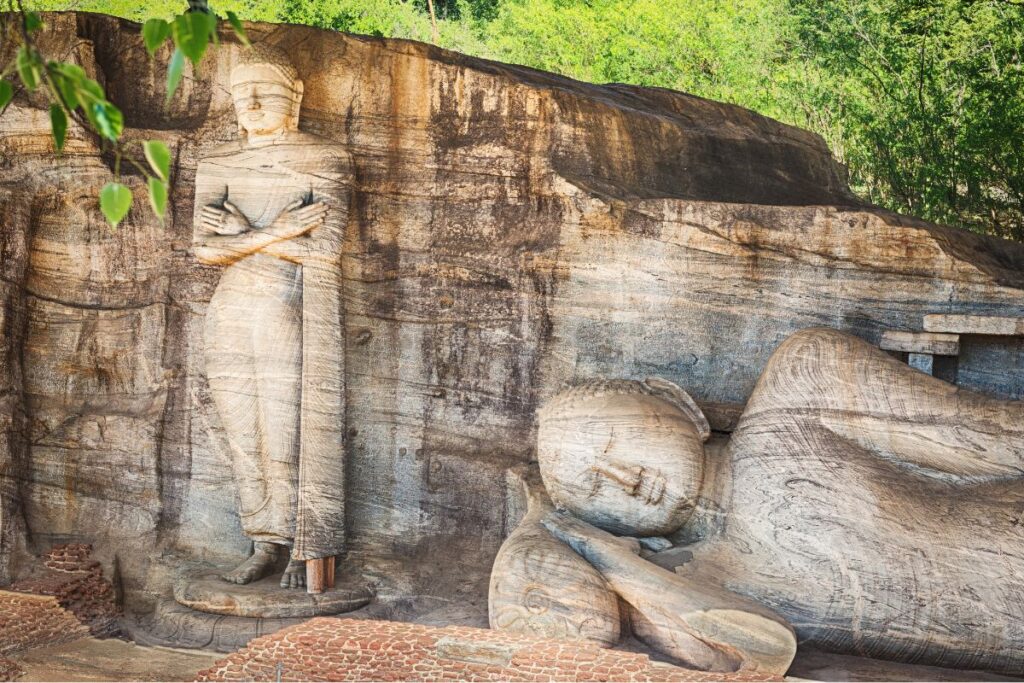
Opposite to Lankatilaka Vihara, down a path by the pond, you’ll find the Gal Vihara, which houses some of the most impressive rock carvings in all of Sri Lanka.
During the reign of King Parakramabahu (1153 to 1186), these massive reliefs were carved into the side of a granite rock, depicting the Buddha in various positions. The tallest sculpture, the standing Buddha, is 7m tall while the reclining Buddha is almost 15m long.
The religious significance of Gal Vihara is still recognised today. In fact, during my visit, there were crowds of people visiting the site to pray before the sculptures.
Even if you’ve seen a thousand rock-carved Buddhas all over Asia, you won’t be disappointed by the Gal Vihara.
Tips for visiting Polonnaruwa
Visit the museum first
As mentioned before, you will gain so much more from that 25 entry ticket if you take the time to learn about Polonnaruwa at the museum first. Seeing the miniatures of the structures during their heyday will help you better understand the ruins you’re exploring.
Remove your shoes (and bring socks)
The ruins of Polonnaruwa’s religious buildings are still considered sacred today, and it’s expected that you remove your shoes, just as you would for any buddhist temple. These stone structures can get HOT in the sun, so I’d also recommend bringing a pair of socks to make it more bearable.
Dress Code
Removing your shoes isn’t the only rule when entering a religious building. It’s also expected that you cover your shoulders and knees. This goes for both men and women. If you don’t want to walk around in the heat with too much clothing on, at least bring something you can wear when visiting the religious sites.
Bring lots of water
The Sri Lankan tropical heat is relentless, and you’re going to be spending a lot of time in the sun and on your feet. Don’t forget to pack some water or else you’ll regret it later. If you run out, there are plenty of stalls around the complex selling cold bottled water.
There you have it, my complete guide to Polonnaruwa. Now you know everything you need to travel to the ancient city. So get out there, or check out one of our other posts below…


